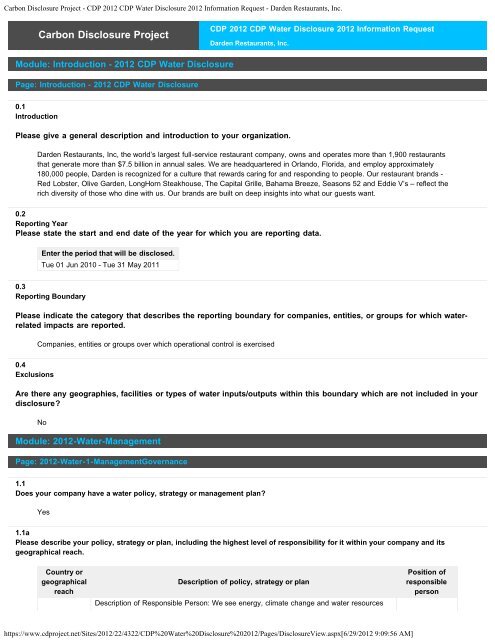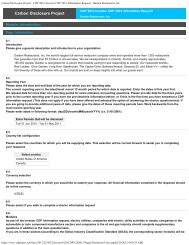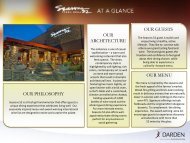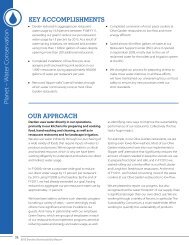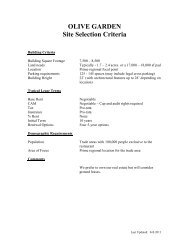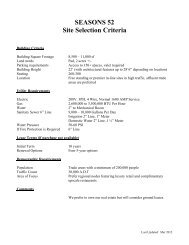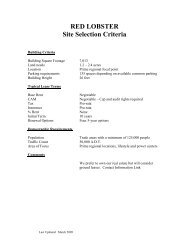Carbon Disclosure Project - Darden Restaurants
Carbon Disclosure Project - Darden Restaurants
Carbon Disclosure Project - Darden Restaurants
- No tags were found...
Create successful ePaper yourself
Turn your PDF publications into a flip-book with our unique Google optimized e-Paper software.
<strong>Carbon</strong> <strong>Disclosure</strong> <strong>Project</strong> - CDP 2012 CDP Water <strong>Disclosure</strong> 2012 Information Request - <strong>Darden</strong> <strong>Restaurants</strong>, Inc.<strong>Carbon</strong> <strong>Disclosure</strong> <strong>Project</strong>CDP 2012 CDP Water <strong>Disclosure</strong> 2012 Information Request<strong>Darden</strong> <strong>Restaurants</strong>, Inc.Module: Introduction - 2012 CDP Water <strong>Disclosure</strong>Page: Introduction - 2012 CDP Water <strong>Disclosure</strong>0.1IntroductionPlease give a general description and introduction to your organization.<strong>Darden</strong> <strong>Restaurants</strong>, Inc, the world’s largest full-service restaurant company, owns and operates more than 1,900 restaurantsthat generate more than $7.5 billion in annual sales. We are headquartered in Orlando, Florida, and employ approximately180,000 people, <strong>Darden</strong> is recognized for a culture that rewards caring for and responding to people. Our restaurant brands -Red Lobster, Olive Garden, LongHorn Steakhouse, The Capital Grille, Bahama Breeze, Seasons 52 and Eddie V’s – reflect therich diversity of those who dine with us. Our brands are built on deep insights into what our guests want.0.2Reporting YearPlease state the start and end date of the year for which you are reporting data.Enter the period that will be disclosed.Tue 01 Jun 2010 - Tue 31 May 20110.3Reporting BoundaryPlease indicate the category that describes the reporting boundary for companies, entities, or groups for which waterrelatedimpacts are reported.Companies, entities or groups over which operational control is exercised0.4ExclusionsAre there any geographies, facilities or types of water inputs/outputs within this boundary which are not included in yourdisclosure?NoModule: 2012-Water-ManagementPage: 2012-Water-1-ManagementGovernance1.1Does your company have a water policy, strategy or management plan?Yes1.1aPlease describe your policy, strategy or plan, including the highest level of responsibility for it within your company and itsgeographical reach.Country orgeographicalreachDescription of policy, strategy or planDescription of Responsible Person: We see energy, climate change and water resourcesPosition ofresponsiblepersonhttps://www.cdproject.net/Sites/2012/22/4322/CDP%20Water%20<strong>Disclosure</strong>%202012/Pages/<strong>Disclosure</strong>View.aspx[6/29/2012 9:09:56 AM]
<strong>Carbon</strong> <strong>Disclosure</strong> <strong>Project</strong> - CDP 2012 CDP Water <strong>Disclosure</strong> 2012 Information Request - <strong>Darden</strong> <strong>Restaurants</strong>, Inc.Other: GlobalOther: GlobalOther: Globalas interlinked issues and the responsibility for these issues is woven throughout theexpanse of our company and organizational layers. Governance for our sustainabilitystrategy and commitments resides at three levels: Board of Directors, Executive Leadershipand Senior Management. The Sustainability Leadership Council (SLC) consists of thesenior executives from most brands and many business units, including operations, supplychain, government affairs, human resources and business development. The SLC meetsthree times a year, advising on sustainability strategy, championing implementation in theirdivisions or brands and providing accountability for performance toward meetingsustainability goals and objectives. This group regularly identifies opportunities, lays outstrategies and develops budgets to address these opportunities. The budgets andstrategies are cascaded to senior management in the operating companies forimplementation. Implementation is primarily handled through facilities or operations groupssupported by directors of operations in the field and supported by Green Teams in theindividual restaurants. Energy, climate change and water are also important issues to our180,000-plus employees, whose commitment and passion is the basis for our relationshipwith our guests, and ultimately our success. Our employees want to know that <strong>Darden</strong>cares and that we are taking meaningful action on environmental challenges. We’ve tappedthis enthusiasm by forming Green Teams at all our restaurants, through which over 10,000employees are helping us cut energy and water use.Description of Water Management Plan – Introduction/Goals/Progress: <strong>Darden</strong> uses waterdirectly in our operations, primarily in our kitchens for preparing/cooking food, handwashing and cleaning, as well as in restrooms and for landscape irrigation. We also usewater indirectly through our purchasing of a wide variety of foods that require inputs ofwater to produce and process (e.g., growing crops and livestock). We recognize that wateris a critical resource, which is why we have been working diligently to understand andreduce our direct and indirect water consumption. In 2009, we set a corporate-wide “15x15over Zero” goal to reduce our direct energy and water use by 15% per restaurant by 2015using FY2008 as the baseline, and of one day sending zero waste to landfill. By the end ofFY2011, we had already exceeded our water goal, having reduced our aggregate perrestaurant water withdrawals by 17.0% compared to our FY2008 baseline. (FYI: <strong>Darden</strong>chose to reset the baseline to FY2008 from FY2006 as it relates to our 15x15 over Zerogoals given the accuracy of data being collected and measured to ensure that our progresswas reported in the most accurate manner possible). We have been able to achievedramatic progress through a variety of steps – from small to significant and most invisible toour guests. Through partnership with our employee Green Teams (groups of employees ineach of our restaurants that implement programs aimed at reducing water, energy andwaste), as well as identifying new ways to improve the sustainability performance of ourrestaurants, we have made a huge impact. As a result of these water-saving initiatives,compared to FY2008 when we began measuring our water usage and assuming businessas usual conditions, we avoided using more than 1 billion gallons of water in FY2011despite opening more than 200 additional restaurants.Description of Water Management Plan – Next Steps: While reduced water withdrawals perrestaurant is significantly ahead of schedule, <strong>Darden</strong> will continue to identify opportunitiesto reduce water use and consider establishing additional goals in FY2013. As we discovernew technologies and practices, we will ensure that they are implemented throughout our1,900-plus restaurants, where feasible. In this way, even small improvements cancumulatively yield big savings. Reducing our water use will help to ensure adequate watersupplies in the long term, it will help us to maintain goodwill in the communities in which weare located, and it makes economic sense since water conservation saves us money. Wealso recognize that the water footprint of our supply chain is larger than our direct waterfootprint and is a more challenging issue to address. Thus, we are actively working with oursuppliers to encourage them to use water wisely. We believe it is critical and are workingthrough a variety of forums – in particular the Sustainability Consortium, which is a multistakeholdereffort working to quantify the sustainability of products – to better understandwater issues in the broader food supply chain. As a major food buyer, we have a strongpositive influence over how our suppliers produce their goods, so we will continue to workclosely with our supply chain on issues relating to water conservation.Board/executiveboardBoard/executiveboardBoard/executiveboard1.1bDoes the water policy, strategy or plan specify water-related targets or goals?https://www.cdproject.net/Sites/2012/22/4322/CDP%20Water%20<strong>Disclosure</strong>%202012/Pages/<strong>Disclosure</strong>View.aspx[6/29/2012 9:09:56 AM]
<strong>Carbon</strong> <strong>Disclosure</strong> <strong>Project</strong> - CDP 2012 CDP Water <strong>Disclosure</strong> 2012 Information Request - <strong>Darden</strong> <strong>Restaurants</strong>, Inc.Yes1.1cPlease describe these water-related targets or goals and the progress your company has made against them.Country orgeographicalreachOther: GlobalCategoryof targetor goaltypeDirectoperationsDescriptionof target orgoalIn 2009, weset acorporatewidegoal toreduce ourdirect waterwithdrawalsby 15% perrestaurantby 2015usingFY2008 asthebaseline.Progress against target or goal<strong>Darden</strong> reduced its aggregate per restaurant water withdrawals by 17.0% betweenFY2008 and FY2011, exceeding our goal to reduce our per restaurant waterwithdrawals by 15% by 2015. Example initiatives in our direct operations include:low-flow pre-rinse sprayers; dipper well replacement; hand-washing sink aerators(kitchens and restrooms); low-flow and energy efficient pasta cookers; use ofreclaimed water for toilets and irrigation system at our new headquarters building;and other miscellaneous initiatives. As a result of these water-saving initiatives,compared to FY2008 when we began measuring our water usage and assumingbusiness as usual conditions, we avoided using more than 1 billion gallons ofwater in FY2011 despite opening more than 200 additional restaurants.1.2Do you wish to report any actions outside your water policy, strategy or management plan that your company has taken to managewater resources or engage stakeholders in water-related issues?Country orgeographicalreachOther: GlobalOther: GlobalCategory ofactionDirectoperationsDirectoperationsDescription of action and outcome<strong>Darden</strong> uses water directly in our operations, primarily in our kitchens for preparing andcooking food, hand washing and cleaning, as well as in restaurant restrooms and forlandscape irrigation. As a result of the following water-saving initiatives, compared to FY2008when we began measuring our water usage and assuming business as usual conditions, weavoided using more than 1 billion gallons of water in FY2011 despite opening more than 200additional restaurants. Example initiatives in our direct operations include: • Installedapproximately 790 low-flow pre-rinse sprayers in dishwashing stations of restaurants that didnot already have them: old sprayers allowed a flow up to 6 gallons per minute (gpm) whilenew ones limit the flow to 1.4 gpm, saving an estimated 225,000 gallons of water perrestaurant per year. • Replaced dipper wells (utensil holders through which water continuouslyruns) in 754 Olive Garden restaurants (98% of the total) by the end of FY2012 (somerestaurants do not have an extra recessed hot well that can be utilized); piloting replacementeffort at Red Lobster and LongHorn Steakhouse restaurants. Estimated savings of over200,000 gallons of water per restaurant per year. • Installed more than 8,500 low-flowaerators on hand-washing sinks in kitchen areas of 1,751 restaurants in late 2009 (somerestaurants had incompatible plumbing). Estimated savings of approximately 195,000 gallonsof water per restaurant per year. • Installed low-flow aerators (~4 per restaurant) in guestrestrooms of 1,800 restaurants (excludes select Olive Garden restaurants with compatibilityissues). Reduced water flow from 2.2 gpm to 0.9 gpm, resulting in savings of 11,580 gallonsof water per restaurant per year. • Completed conversion of 99% of pasta cookers at OliveGarden restaurants by the end of FY2011 to be low-flow and more energy efficient. Reducedwater flow from 0.8 gpm to 0.5 gpm per unit.• In early 2010, all Olive Garden, Red Lobster, and LongHorn Steakhouse restaurantsimplemented a less water-intensive method for cleaning floors that uses an enzymatic cleanerthat does not require intensive rinsing with water: estimated savings of approximately 50Mgallons of water annually. • New procedure to remove ice from beverage stations and coldwells in Olive Garden restaurants prior to cleaning rather than melting ice with hot water:saves approximately 100 gallons of hot water per week per restaurant, or about 4 millionhttps://www.cdproject.net/Sites/2012/22/4322/CDP%20Water%20<strong>Disclosure</strong>%202012/Pages/<strong>Disclosure</strong>View.aspx[6/29/2012 9:09:56 AM]
<strong>Carbon</strong> <strong>Disclosure</strong> <strong>Project</strong> - CDP 2012 CDP Water <strong>Disclosure</strong> 2012 Information Request - <strong>Darden</strong> <strong>Restaurants</strong>, Inc.Other: GlobalOther: GlobalOther: GlobalDirectoperationsDirectoperationsSupply chainandwatershedmanagementgallons per year for Olive Garden, coupled with the energy required to heat the water. •Replaced Olive Garden ice makers with more energy and water efficient, Energy Star-ratedand LEED-compatible ice machines: saves 3.3 gallons of water and 0.6 kWh of electricity per100 pounds of ice.• New headquarters building – called our Restaurant Support Center (RSC) – opened inSeptember 2009 and received the U.S. Green Building Council’s Leadership in Energy andEnvironmental Design (LEED) Gold certification in 2010. In our first year (9/09-8/10), wesaved 18.3 million gallons of potable water through the use of reclaimed water for theirrigation system and toilets; we saved 19.5 million gallons in year two (9/10-8/11). Otherwater-saving initiatives include restroom sinks featuring auto on/off sensors; water-efficientlandscaping consisting of native Florida plants and trees; bioswales around the buildings thatslow the runoff of rainwater, filter out contaminants, and recharge the groundwater rather thanhaving stormwater drain directly into nearby ponds; and elimination of 250,000 bottles ofwater annually by giving all RSC employees a reusable travel cup and discontinuing freebottled water in break rooms prior to moving to the new RSC building. • Green BuildingsInitiatives: new restaurant prototypes for Olive Garden, Red Lobster, LongHorn Steakhouse,and Bahama Breeze aligned with the LEED certification standard (using recycled materials inconstruction and designed to reduce energy and water use and minimize waste); majorremodeling efforts at existing Olive Garden, Red Lobster, and Longhorn Steakhouserestaurants (LED/compact florescent lighting, smarter energy management systems, recycledmaterials, less water-intensive landscaping, low-flow water nozzles and faucets, and locallysourced materials); 13 Olive Garden, Red Lobster, and Longhorn Steakhouse restaurantspursuing LEED Silver certification to help build our knowledge and experience withsustainable design for application across our portfolio (will pursue LEED certification in selectinstances going forward).• Evaluating other advanced technology equipment options designed to reduce water andenergy use: piloting lower-flow dishwashers in Olive Garden restaurants to reduce water andenergy usage; evaluating potential steamer alternatives in Red Lobster restaurants to lowerutility costs, saving a potential 29,244 MWh of electricity per year and 177.5 million gallons ofwater per year. • Miscellaneous initiatives: implemented an enterprise-wide, 30-point leakinspection process by restaurant Green Teams in late 2009; using drip irrigation and moreindigenous and drought-resistant plant species for landscaping at all new restaurants;launching the Cleaning Chemical Usage Improvement initiative in Olive Garden restaurants toeducate employees about the proper use of “the right cleaning chemicals, in the right way,using the right amount,” which will reduce chemical usage as well as water usage byminimizing or eliminating the need for re-washing; and less water-intensive shrimp thawingprocesses.<strong>Darden</strong> uses water indirectly through purchasing of a wide variety of foods that require inputsof water to produce and process (e.g., growing crops and livestock). As a major food buyer,we have a strong positive influence over how our suppliers produce their goods, so we willcontinue to work closely with our supply chain on issues relating to water conservation.<strong>Darden</strong> also focuses on opportunities where we can improve the sustainability of our supplychain by partnering with key suppliers, scientists, industries and communities. Exampleinitiatives in our supply chain include: • By sourcing produce directly from farmers, we are ableto ensure that they meet our stringent specifications and standards for everything from foodsafety to working conditions to growing practices, including standards for water use and waterquality. o Drip irrigation: we require farmers in Mexico (where approximately half of ourproduce is grown) to use drip irrigation rather than spray irrigation; we also encouragesuppliers in the U.S. to use drip irrigation. o Strict supplier requirements for water quality: inMexico and Latin America, we require farmers to ensure that irrigation water used is of thehighest quality and meets strict biological standards (as opposed to “recreational use”standards); also require farmers to provide fencing to keep animals out of the fields and tohave proper latrine facilities for workers for the purposes of food safety and proper hygiene. •In 2009, we established a cross-functional <strong>Darden</strong> Supply Chain Sustainability team tocoordinate or initiate new efforts to address specific issues in our supply chain, such asfurthering seafood sustainability. In addition, we have established expectations for andregularly engage our suppliers on a range of sustainability issues, from human and laborrights to animal welfare to seafood sustainability. Our approach emphasizes the importance ofintegrated management systems to better ensure sustainable supplier practices andtraceability, and to develop long-term, mutually-beneficial relationships with our suppliers,https://www.cdproject.net/Sites/2012/22/4322/CDP%20Water%20<strong>Disclosure</strong>%202012/Pages/<strong>Disclosure</strong>View.aspx[6/29/2012 9:09:56 AM]
<strong>Carbon</strong> <strong>Disclosure</strong> <strong>Project</strong> - CDP 2012 CDP Water <strong>Disclosure</strong> 2012 Information Request - <strong>Darden</strong> <strong>Restaurants</strong>, Inc.Other:EvergladesWatershedOther:NorthernEvergladesWatershedOther: GlobalSupply chainandwatershedmanagementSupply chainandwatershedmanagementSupply chainandwatershedmanagementworking with them constructively and cooperatively to improve their sustainability performancewhen needed.Everglades <strong>Project</strong> (http://dardenfoundation.com/index.php/foundation-partners/preservationof-natural-resources/everglades-foundation.html):• <strong>Darden</strong> has partnered with TheEverglades Foundation to guarantee clean water for all Floridians by restoring this criticalecosystem. With <strong>Darden</strong>’s support, The Everglades Foundation aims to reverse the damageinflicted upon the ecosystem by implementing scientifically accurate and feasible solutions,and seeks to provide the public and policymakers with an honest and credible resource tohelp guide decision-making on complex restoration issues. • In 2009, The EvergladesFoundation commissioned an economics study funded by <strong>Darden</strong>, which found that the resultsfrom an $11 billion Everglades restoration would result in $45 billion in benefits. <strong>Darden</strong>’ssupport has enabled The Everglades Foundation’s scientists to work with universities andagencies to embark on a series of projects related to improving the health of the Everglades.Restoration plans will improve water quality and storage methods for future use, as well asremove the barriers to nutrient-rich runoff from agricultural lands, all of which will positivelycontribute to the state’s economy. • Water resources in Florida, home to <strong>Darden</strong>’s corporateheadquarters, are being stretched to their limits. <strong>Darden</strong> and The Everglades Foundation areproud of this unique partnership, which will improve the quality of Florida’s water and ensurethat freshwater will be drinkable, fishable, and swimmable for all.Audubon Program (http://dardenfoundation.com/index.php/foundation-partners/preservationof-natural-resources/audubon-of-florida.html):• Audubon of Florida receives support from<strong>Darden</strong> for its Northern Everglades watershed program, which promotes cattle ranching whilesolving the water resource challenges threatening Lake Okeechobee, the Everglades and thelake-to-Gulf and Gulf-to-Atlantic downstream estuaries. By engaging ranchers as partners inimproved water management, Audubon and <strong>Darden</strong> help ranches become more profitablewhile reducing harmful nutrients and complying with state regulations. • As a result of thiseffort, more than 16,000 acres of ranchland adjacent to Lake Okeechobee are being used tostore and treat water before it harms the Everglades. The project has also helped Audubonmake the case to government agencies for doubling funds to pay ranchers for ecologicalservices. • The relationship between Audubon, <strong>Darden</strong> and other community advocates hashelped protect and restore America’s Everglades, one of the world’s unique naturalecosystems, and to ensure freshwater and a thriving ecosystem in Florida (home to <strong>Darden</strong>’sheadquarters) for many years to come.Product Performance: We define our products as the meals served in our restaurants everyday. Two key aspects of our restaurants’ meals are vital to our sustainability strategy: foodsafety and seafood sustainability. • <strong>Darden</strong> has rigorous, state-of-the-art food safety systemsthat reach from our restaurants to our supply chain. Training our restaurant employees (e.g.,National Restaurant Association program) is an important foundation for food safety. • We arealso committed to helping ensure sustainable stocks of seafood – for the sake of our businessand for the sake of preserving ocean ecosystems for generations to come. We currently donot serve species that are considered at risk, such as shark and orange roughy, as thesespecies are overfished at present. We are committed to purchasing species from sustainablesources. We have worked with governments to strengthen policies regarding wild-caughtspecies such as North Atlantic lobsters and Caribbean rock lobsters, and we have partneredwith conservation groups, such as the New England Aquarium, to learn more about thescience behind the fisheries and to help ensure that the species we serve are sustainable,based on the best science of the day. • We are also committed to responsible aquaculture sowe can supplement the supply of seafood while avoiding the depletion of species. Our goal isto have all of our aquaculture products certified to the standards of the Global AquacultureAlliance (a multi-stakeholder nonprofit organization we co-founded in 1997) as they becomeavailable. Already, 100% of the aquacultured shrimp processors that supply <strong>Darden</strong> arecertified.Underpinning our sustainability strategy is <strong>Darden</strong>’s commitment to collaboration andstakeholder engagement. Many of the issues we are working to address are complex, andcomplex problems require collaborative solutions. There is much we can learn from theperspective and experience of others, which is why we are working with our businesspartners, government agencies, academic institutions, non-governmental organizations andothers as part of our sustainability efforts. We believe that working collaboratively and with agenuine commitment to finding shared solutions helps <strong>Darden</strong> earn the trust of ourstakeholders, and a seat at the table to help shape responses to the issues that affect ourhttps://www.cdproject.net/Sites/2012/22/4322/CDP%20Water%20<strong>Disclosure</strong>%202012/Pages/<strong>Disclosure</strong>View.aspx[6/29/2012 9:09:56 AM]
<strong>Carbon</strong> <strong>Disclosure</strong> <strong>Project</strong> - CDP 2012 CDP Water <strong>Disclosure</strong> 2012 Information Request - <strong>Darden</strong> <strong>Restaurants</strong>, Inc.Other: GlobalOther: GlobalOther: GlobalCollectiveactionCollectiveactionCollectiveactioncompany. • <strong>Darden</strong> is a founding member of The Sustainability Consortium, currently servingas a member of the Steering Committee and Retail Sector Lead. The SustainabilityConsortium is a multi-stakeholder collaboration bringing together companies, academics,NGOs and government agencies, whose vision is “to advance science to drive a newgeneration of innovative products and supply networks that address environmental, social,and economic imperatives.” The goal is to better understand the energy, carbon and waterfootprint of the foods we buy and develop a uniform life cycle analysis and approach toaddress potential hot spots. • <strong>Darden</strong> recently joined the World Bank’s Global Partnership forOceans (GPO). This effort brings together stakeholders from all segments of the spectrum tocollaborate with the purposes of making the oceans healthy and to optimize the ocean’sproductivity in a sustainable manner. The GPO has provided a forum where private industry,NGO’s, government, scientists and academia have come together and are willing tocooperate through open and transparent communication. The GPO will become a catalyst forpositive change by bringing the world together to tackle the challenges of providing healthyand productive oceans for generations to come.New England Aquarium (NEAq) & Ocean Health Index (OHI)(http://dardenfoundation.com/index.php/foundation-partners/preservation-of-naturalresources/new-england-aquarium.html):• NEAq has provided on-going consultation since2005 on a host of seafood-related issues and has been a trusted advisor to our Supply Chain,Total Quality and Sustainability groups. • <strong>Darden</strong> has partnered with NEAq for over a decadeto provide up-to-date environmental, conservation and scientific data regarding wild-capturefish and aquaculture species for our Seafood Sustainability Dashboard. The Dashboard isintended to further educate <strong>Darden</strong>’s seafood buyers about the factors that should beconsidered when making a responsible purchase. • In 2010, <strong>Darden</strong> provided additionalsupport to respond to the major threats facing the oceans today, such as overfishing,pollution, habitat loss and climate change, by supporting the Ocean Health Index (OHI)initiative. Recognizing the need for a framework to measure ocean health, NEAq,Conservation International and the National Geographic Society are creating an index usinggoals or indicators drawn from international agreements and other high-levelrecommendations regarding marine conservation and resource use. OHI indicators willmeasure changes in the intensity of the most critical ocean stressors, their direct effects onthe ocean, impacts on ocean subsidies and services and consequences for human wellbeing.With <strong>Darden</strong>’s support, NEAq is developing a Sentinel Species Indicator (SSI) for theOHI, which uses the status of animals to reflect the ecosystem consequences of humanactions. Scheduled to be launched in early 2012, OHI results will be published in a dramaticand accessible format designed to maximize utility to the public, ocean managers andstakeholders, and energize transformative change in attitudes and behavior regarding oceanuse and conservation.• Fishery Improvement <strong>Project</strong>s (FIPs) & Clinton Global Initiative (CGI): In FY2011, <strong>Darden</strong>announced a commitment to rebuilding troubled fisheries through three targeted FisheryImprovement <strong>Project</strong>s (FIPs). The commitment is part of <strong>Darden</strong>’s membership in the ClintonGlobal Initiative (CGI) and was recognized by CGI as an exemplary approach to addressingenvironmental challenges. The initial FIP was launched in partnership with Publix SuperMarkets and Sustainable Fisheries Partnership in the U.S. Gulf of Mexico. The focus is tosupport the rebuilding of commercial reef fish fisheries, primarily grouper and red snapper,using several tools including the development of data collection methods to enhancemanagement, testing different gear types to reduce interactions with sea turtles, and buildingnew markets for the fish as populations recover. • We are beginning to work with our peercompanies and other interested stakeholders to address water issues in the broaderagricultural system, and we will continue to seek out multi-stakeholder mechanisms thatinvolve our peer companies and other organizations to help promote sustainable water usemore broadly. • Global Aquaculture Alliance: <strong>Darden</strong> played a key role in establishing theGlobal Aquaculture Alliance, a multi-stakeholder partnership we cofounded, which provides aforum for experts from multiple sectors to develop standards for environmentally and sociallyresponsible aquaculture practices. • <strong>Darden</strong> is a member in a host of corporate socialresponsibility forums designed to accelerate our sustainability leadership. Organizationsinclude the Corporate Eco-Forum, Business for Social Responsibility, and ConservationInternational’s Business & Sustainability Council. • <strong>Darden</strong> is a member of a wide range ofindustry associations that address various aspects of supply chain sustainability, such asGlobal Aquaculture Alliance, National Fisheries Institute, Sustainable Fisheries Partnership,https://www.cdproject.net/Sites/2012/22/4322/CDP%20Water%20<strong>Disclosure</strong>%202012/Pages/<strong>Disclosure</strong>View.aspx[6/29/2012 9:09:56 AM]
<strong>Carbon</strong> <strong>Disclosure</strong> <strong>Project</strong> - CDP 2012 CDP Water <strong>Disclosure</strong> 2012 Information Request - <strong>Darden</strong> <strong>Restaurants</strong>, Inc.Other: GlobalOther: GlobalOther: GlobalOther: GlobalCollectiveactionPublic policyCommunityengagementTransparencyLobsterman Association, National Restaurant Association, National Council of Chain<strong>Restaurants</strong>, Food Safety Leadership Council, International Association for Food Protection,and the National Environmental Health Association.• Green Teams: In 2009, we established employee Green Teams as a way to more formallyorganize and involve employees in our sustainability efforts. These groups in each restauranthelp implement initiatives aimed at reducing water, energy and waste, gather good ideas fromstaff, communicate sustainability efforts, and improve our performance. While the activities ofeach team may seem small in isolation, they make a huge impact when multiplied by <strong>Darden</strong>’s1,900-plus restaurants. Some sharing of ideas and best practices takes place among theindividuals at each of these levels, and we hope to encourage more of that in the future.• <strong>Darden</strong> seeks to be more influential in the public policy arena. For example, we haveassumed a leadership position on such global issues as the sustainability of our vitalresources, particularly seafood. We work closely with NOAA, USAID, the World Bank, NMFS,the FAO, and many government or non-governmental organizations to positively influencepublic policy.• <strong>Darden</strong> Foundation currently focuses philanthropic efforts on three core areas includingaccess to post-secondary education, preservation of natural resources (wildlife protection,restoration and preservation of ecosystems, and teaching environmental sustainability), andgood neighbor grants. The FY13 strategy for preservation of natural resources involvesfocusing on the following: water (both freshwater and oceans), parks, and sustainableagriculture. • In FY2011, the <strong>Darden</strong> Restaurant Foundation supported a broad range oforganizations, including the following organizations focused on preservation of naturalresources: New England Aquarium, The Everglades Foundation, and Audubon of Florida.• CDP Water <strong>Disclosure</strong>: This is <strong>Darden</strong>’s first year responding to the CDP Water <strong>Disclosure</strong>information request. We recognize the importance of transparently reporting our water dataand disclosing water-related actions that we are already undertaking or will be undertaking inthe future. Measuring and reporting on our environmental impact related to water is expectedto lead to greater awareness of water-related issues and is key to the success of oursustainability program. It will also help us to identify potential risks and opportunities within ourportfolio or at a particular facility and help to mitigate those risks or further exploreopportunities. • Sustainability Report: <strong>Darden</strong> also released its inaugural Sustainability Reportin May 2010, which introduced our sustainability strategy, outlined our most material issuesand described many of the strategies we employ to reduce our impact on the planet. We arecurrently working on the 2012 update, where we will share the insights we have learned, theprogress we have made on our goals, and outline how partnerships with key stakeholdershave advanced our strategy over the last two years. The report focuses on materialdevelopments and activities related to sustainability at <strong>Darden</strong> from the prior report forFY2010 to today. We used the Global Reporting Initiative (G3) Guidelines to help shape thecontent of the report, and are self-declaring the report to be at a C Application Level. Goingforward, <strong>Darden</strong> intends to maintain a two-year sustainability reporting cycle. We also plan toprovide more regular and real-time updates about our sustainability activities andperformance via our updated sustainability website, www.darden.com/sustainability.Module: 2012-Water-RisksOpsPage: 2012-Water-2-indicators-op2.1Are any of your operations located in water-stressed regions?Yes2.1aPlease specify the method(s) you use to characterize water-stressed regions (you may choose more than one method).Method used todefine waterstressPlease add any comments here:<strong>Darden</strong> primarily relies on outputs from the WBCSD Global Water Tool to gain a high-level understandinghttps://www.cdproject.net/Sites/2012/22/4322/CDP%20Water%20<strong>Disclosure</strong>%202012/Pages/<strong>Disclosure</strong>View.aspx[6/29/2012 9:09:56 AM]
<strong>Carbon</strong> <strong>Disclosure</strong> <strong>Project</strong> - CDP 2012 CDP Water <strong>Disclosure</strong> 2012 Information Request - <strong>Darden</strong> <strong>Restaurants</strong>, Inc.FAO/AQUASTATInternal companyknowledgeWBCSD WaterToolWRI waterscarcity definitionof specific restaurants located in water stressed regions. With operations in the U.S. and Canada, theprimary metrics evaluated include the Mean Annual Relative Water Stress Index and Annual RenewableWater Supply per Person – 1995 and 2025 <strong>Project</strong>ions. For the Mean Annual Relative Water Stress Index,we consider scarce (ratio >1; hyper-stressed) and stressed (ratio of 0.4 – 1.0; a highly stressed system,and one that is more than likely over-tapping the resources needed to sustain a functioning freshwaterecosystem) regions. For the 1995 and <strong>Project</strong>ed 2025 Annual Renewable Water Supply per Person, areaswhere per capita water supply drops below 1,700 m3/year are defined as experiencing water stress (asituation in which disruptive water shortages can frequently occur). In this response, we have chosen tofocus on areas of extreme scarcity (
<strong>Carbon</strong> <strong>Disclosure</strong> <strong>Project</strong> - CDP 2012 CDP Water <strong>Disclosure</strong> 2012 Information Request - <strong>Darden</strong> <strong>Restaurants</strong>, Inc.of AmericaUnited Statesof AmericaUnited Statesof AmericaUnited Statesof AmericaUnited Statesof AmericaOther:Company-WideUnited Statesof AmericaUnited Statesof AmericaUnited Statesof AmericaUnited Statesof AmericaUnited Statesof AmericaUnited Statesof AmericaUnited Statesof AmericaUnited Statesof AmericaOther:Company-WideCaliforniaFloridaMarylandNewYorkUtahUnitedStates &CanadaTexasCaliforniaFloridaMarylandNewYorkSouthCarolinaUtahNewMexicoUnitedStates &CanadaWater Supply per Person,1995Other: Annual RenewableWater Supply per Person,1995Other: Annual RenewableWater Supply per Person,1995Other: Annual RenewableWater Supply per Person,1995Other: Annual RenewableWater Supply per Person,1995Other: Annual RenewableWater Supply per Person,1995Other: Annual RenewableWater Supply per Person,2025 <strong>Project</strong>ionsOther: Annual RenewableWater Supply per Person,2025 <strong>Project</strong>ionsOther: Annual RenewableWater Supply per Person,2025 <strong>Project</strong>ionsOther: Annual RenewableWater Supply per Person,2025 <strong>Project</strong>ionsOther: Annual RenewableWater Supply per Person,2025 <strong>Project</strong>ionsOther: Annual RenewableWater Supply per Person,2025 <strong>Project</strong>ionsOther: Annual RenewableWater Supply per Person,2025 <strong>Project</strong>ionsOther: Annual RenewableWater Supply per Person,2025 <strong>Project</strong>ionsOther: Annual RenewableWater Supply per Person,2025 <strong>Project</strong>ions1-10 on the 1995 Annual Renewable WaterSupply per Person.Regions of extreme scarcity/scarcity based1-10on the 1995 Annual Renewable WaterSupply per Person.Regions of extreme scarcity/scarcity based1-10on the 1995 Annual Renewable WaterSupply per Person.Regions of extreme scarcity/scarcity based1-10on the 1995 Annual Renewable WaterSupply per Person.Regions of extreme scarcity/scarcity based1-10on the 1995 Annual Renewable WaterSupply per Person.Regions of extreme scarcity/scarcity based11-20on the 1995 Annual Renewable WaterSupply per Person.Regions of extreme scarcity/scarcity based1-10on the projected 2025 Annual RenewableWater Supply per Person.Regions of extreme scarcity/scarcity based1-10on the projected 2025 Annual RenewableWater Supply per Person.Regions of extreme scarcity/scarcity based1-10on the projected 2025 Annual RenewableWater Supply per Person.Regions of extreme scarcity/scarcity based1-10on the projected 2025 Annual RenewableWater Supply per Person.Regions of extreme scarcity/scarcity based1-10on the projected 2025 Annual RenewableWater Supply per Person.Regions of extreme scarcity/scarcity based1-10on the projected 2025 Annual RenewableWater Supply per Person.Regions of extreme scarcity/scarcity based1-10on the projected 2025 Annual RenewableWater Supply per Person.Regions of extreme scarcity/scarcity based1-10on the projected 2025 Annual RenewableWater Supply per Person.Regions of extreme scarcity/scarcity based11-20on the projected 2025 Annual RenewableWater Supply per Person.2.3Please specify the total proportion of your operations that are located in the regions at risk which you identified in questions 2.1and/or 2.2.24%2.4Please specify the basis you use to calculate the proportions used for questions 2.1 and/or 2.2.Basis used to determine proportionsNumber of facilitiesPlease add any comments herehttps://www.cdproject.net/Sites/2012/22/4322/CDP%20Water%20<strong>Disclosure</strong>%202012/Pages/<strong>Disclosure</strong>View.aspx[6/29/2012 9:09:56 AM]
<strong>Carbon</strong> <strong>Disclosure</strong> <strong>Project</strong> - CDP 2012 CDP Water <strong>Disclosure</strong> 2012 Information Request - <strong>Darden</strong> <strong>Restaurants</strong>, Inc.Page: 2012-water-indicators-sc2.5Do any of your key inputs or raw materials (excluding water) come from regions subject to water-related risk?Yes2.5aPlease state or estimate the proportion of your key inputs or raw materials that come from regions subject to water-related risk.Input ormaterialProportionof keyinput orrawmaterialthatcomesfromregion atrisk (%)Unit usedforcalculatingpercentageFurther commentsProduce;ProteinsOther: NotspecificallycalculatedWhile we have not yet completed water scarcity mapping of our key inputs or rawmaterials, we recognize that some of our key inputs do come from regions subject towater-related risk, such as produce sourced from water scarce areas of California. Wehave also begun work to better understand the energy/carbon and water footprints ofsome of the foods we buy and are exploring ways to minimize them. Our efforts in thisarea are in their early stages with issues and solutions that are not always within oursphere of control. Nonetheless, we think it is critical work, with dual drivers and dualbenefits.Page: 2012-water-3-riskassess-op3.1Is your company exposed to water-related risks (current or future) that have the potential to generate a substantive change in yourbusiness operation, revenue or expenditure?No3.1bPlease explain why you do not consider your company to be exposed to any water-related risks that have the potential to generate asubstantive change in your business operation, revenue or expenditure.While we recognize that our company is exposed to several water-related risks within our direct operations, given thenumber and locality of our restaurants and how we use water, we do not believe these risks have the potential to causea substantive change in our business operation, revenue, or expenditure. Some of the water-related risks that we areexposed to on a lesser scale include the following: • 01. Physical: Declining water quality – Declining water quality couldlead to increased water prices from municipalities associated with treatment, which could decrease our operatingprofits and necessitate future investments in facilities/equipment. • 02. Physical: Flooding - Some climatologists predictthat long-term effects of climate change may result in more severe, volatile weather. As such, select restaurants may besubject to interruptions to the availability of water due to extreme weather events, including flooding. This couldnecessitate future investments in facilities/equipment. Furthermore, our inability to anticipate and respond effectively toan adverse change could negatively affect our sales. • 03. Physical: Increased water stress or scarcity – Interruptions tothe availability of water as a result of increased water stress/scarcity could lead to increased water prices frommunicipalities and/or restrictions on use, which could decrease our operating profits and necessitate future investmentsin facilities/equipment. Our inability to anticipate and respond effectively to an adverse change in water availabilitycould also negatively affect our sales. • 06. Regulatory: Higher water prices – Our restaurants’ operating margins areaffected by fluctuations in the price of water utilities, whether as a result of inflation or otherwise. Fluctuations in waterprices and failure to achieve economies of scale in utility pricing could adversely affect our operations and lead tohigher operational costs, ultimately affecting our bottom line. In addition, if water prices increase, our guests may havelower disposable income and reduce the frequency with which they dine out, may spend less on each dining outoccasion, or may choose more inexpensive restaurants. Any significant decrease in our customer traffic or averagehttps://www.cdproject.net/Sites/2012/22/4322/CDP%20Water%20<strong>Disclosure</strong>%202012/Pages/<strong>Disclosure</strong>View.aspx[6/29/2012 9:09:56 AM]
<strong>Carbon</strong> <strong>Disclosure</strong> <strong>Project</strong> - CDP 2012 CDP Water <strong>Disclosure</strong> 2012 Information Request - <strong>Darden</strong> <strong>Restaurants</strong>, Inc.profit per transaction will negatively impact our financial performance. • 08. Regulatory: Mandatory water efficiency,conservation, recycling or process standards / 11. Regulatory: Statutory water withdrawal limits/changes to waterallocation – Such standards/limitations could affect how we use water within our operations, such as restrictions on thevolume of water allocated for irrigation. A large percentage of our operations in the western U.S. are already facing strictwater conservation guidelines. Regulatory initiatives focused on minimizing/limiting water withdrawals could result infuture increases in the cost of raw materials, municipality charges, or taxes, which could decrease our operating profitsand necessitate future investments in facilities/equipment. • 09. Regulatory: Regulation of discharge quality/volumes –Regulation of discharge quality/volumes could result in increased discharge costs from the municipality, leading tohigher operational costs and ultimately affecting our bottom line. • 15. Other: Reputational risk – Potential reputationalrisks associated with perceived water inefficiencies in our direct operations and/or perceived inaction in our supplychain, particularly in regards to our supplier’s agricultural or aquaculture practices, could negatively impact stakeholderperceptions of our company. This could adversely affect our operations and sales. Furthermore, the full service diningsector of the restaurant industry is affected by changes in consumer spending patterns and consumer preferences,including changes in consumer tastes and dietary habits and the level of consumer acceptance of our restaurantbrands. Any negative stakeholder perceptions may adversely affect consumer behavior and our operational results. • 16.Other. Inadequate infrastructure – Since we rely heavily on municipal water supplies, interruptions to the availability ofwater due to aging or inadequate infrastructure could affect the water supply to some of our restaurants, which couldnecessitate future investments in facilities/equipment. Furthermore, our inability to anticipate and respond effectively toan adverse change could negatively affect our sales.3.2What methodology and what geographical scale (e.g. country, region, watershed, business unit, facility) do you use to analyze waterrelatedrisk across your operations?Risk methodologyFacility: Water footprinting is utilized to provide an overall picture of how much water is used and where from ageographical point of view. The results are then overlaid with numerous risk maps generated using theWBCSD Global Water Tool, which facilitates a more comprehensive view of physical water-related risks andidentification of priority areas. Additional regulatory and reputational risks are also evaluated utilizing internalcompany knowledge. Global: Each year management conducts the Enterprise Risk Assessment (ERA)facilitated by Internal Audit and reviewed with the Audit Committee and full Board. Our threshold for evaluatingmateriality and the related criteria are considered a business confidential process at <strong>Darden</strong>. If a material riskis identified, however, it is reported to executive leadership and the Board of Directors, on an as needed basisjust as any other potential corporate risk would be reported. In our latest 10K filed for FY2011, <strong>Darden</strong>identified several issues regarding climate change and/or environmental issues. We noted, for example, thatwe have seen an increasing focus by U.S. and overseas governmental authorities on environmental matters,such as climate change, the reduction of greenhouse gases and water consumption (Page 15). Suchlegislative or regulatory initiatives could result in future increases in the cost of our raw materials, taxes andutilities. We also noted that the price and availability of key food products could be impacted by interruptionsto the availability of gas, electric, water or other utilities. Some climatologists predict that the long-term effectsof climate change may result in more severe, volatile weather (Page 19). We also not that unfavorablepublicity, or failure to respond effectively to adverse publicity, could harm our reputation and adversely impactour guest counts and sales. Such negative publicity could results, among other things, from health concernsincluding food safety and environmental disasters (Page 14).Country orgeographicalscaleFacilityPage: 2012-water-riskassess-sc3.3Do you require your key suppliers to report on their water use, risks and management?No3.4Is your supply chain exposed to water-related risks (current or future) that have the potential to generate a substantive change in yourbusiness operation, revenue or expenditure?Yeshttps://www.cdproject.net/Sites/2012/22/4322/CDP%20Water%20<strong>Disclosure</strong>%202012/Pages/<strong>Disclosure</strong>View.aspx[6/29/2012 9:09:56 AM]
<strong>Carbon</strong> <strong>Disclosure</strong> <strong>Project</strong> - CDP 2012 CDP Water <strong>Disclosure</strong> 2012 Information Request - <strong>Darden</strong> <strong>Restaurants</strong>, Inc.3.4aPlease describe (i) the current and/or future risks to your supply chain, (ii) the ways in which these risks affect or could affect youroperations before taking action, (iii) the estimated timescale of these risks and, (iv) your current or proposed strategies for managingthem.Country orgeographicalreachGlobalGlobalRisk type (tosupplier)01. Physical:Decliningwater quality02. Physical:FloodingPotential business impact (toresponding company)Declining water quality couldimpact our suppliers in anumber of ways, such asreduced agricultural cropyields, shortage of animal feed,or aquaculture issues. Possibleshortages or interruptions inthe supply of food items andother supplies to ourrestaurants and a failure toachieve economies of scale inpurchasing could adverselyaffect the availability, qualityand cost of the items we buyand the operations of ourrestaurants.Possible shortages or seasonalinterruptions in the supply offood items and other suppliesto our restaurants caused byunpredictable weather ornatural disasters, such asfloods/droughts andearthquakes, could adverselyaffect the availability, qualityand cost of the items we buyand the operations of ourrestaurants. We may have alimited number of suppliers forcertain products. Supply chainrisks could increase our costsand limit the availability ofproducts that are critical to ourrestaurant operations. If wetemporarily close a restaurantor remove popular items from aEstimatetimescale(years)11 – 20CurrentRisk management strategies (byresponding company)Strict supplier requirements for water quality:in Mexico and Latin America, we requirefarmers to ensure that irrigation water used isof the highest quality and meets strictbiological standards (as opposed to“recreational use” standards); also requirefarmers to provide fencing to keep animals outof the fields and to have proper latrine facilitiesfor workers for the purposes of food safetyand proper hygiene. For seafood suppliers,<strong>Darden</strong> has partnered with the New EnglandAquarium for over a decade to provide up-todateenvironmental, conservation andscientific data regarding wild-capture fish andaquaculture species for our SeafoodSustainability Dashboard. The Dashboard isintended to further educate <strong>Darden</strong>’s seafoodbuyers about the factors that should beconsidered when making a responsiblepurchase. Furthermore, in 2010, <strong>Darden</strong>provided additional support to respond to themajor threats facing the oceans today, such asoverfishing, pollution, habitat loss and climatechange, by supporting the Ocean Health Index(OHI) initiative. Recognizing the need for aframework to measure ocean health, NEAq,Conservation International and the NationalGeographic Society are creating an indexusing goals or indicators drawn frominternational agreements and other high-levelrecommendations regarding marineconservation and resource use.Ten years ago, all fresh fruits and vegetablesused in our restaurants came from farms in theUnited States. However, we began to realizethat we were relying too heavily on farmers inonly two U.S. states – Florida and California.This dependence grew especially evident in2004 after a series of hurricanes in Florida,coupled with unfavorable weather in California,wiped out tomato crops and drove up prices.What we needed was geographic diversity,and we began to expand our supplier farms toareas such as Mexico and Latin America.Today, approximately half of our produce ishttps://www.cdproject.net/Sites/2012/22/4322/CDP%20Water%20<strong>Disclosure</strong>%202012/Pages/<strong>Disclosure</strong>View.aspx[6/29/2012 9:09:56 AM]
<strong>Carbon</strong> <strong>Disclosure</strong> <strong>Project</strong> - CDP 2012 CDP Water <strong>Disclosure</strong> 2012 Information Request - <strong>Darden</strong> <strong>Restaurants</strong>, Inc.restaurant’s menu, thatrestaurant may experience asignificant reduction in salesduring the time affected by theshortage or thereafter as aresult of our customerschanging their dining habits.Interruptions to the availabilityof water as a result ofincreased water stress/scarcitymay adversely affect oursuppliers (e.g., reduced cropyields or inability to growcertain crops). We may losesales or incur increased costsif our restaurants experienceshortages or interruptions inthe delivery of food and otherproducts from suppliers.Furthermore, agriculture willhave to compete withincreasing population, industry,the environment, etc., andconversely, urban populationswill compete with agriculturefor decreasing supplies. Suchcompetition for water resourcescould result in negativestakeholder perceptions thatmay adversely affect consumerbehavior and our operationalresults.grown in Mexico.Global03. Physical:Increasedwater stressor scarcity11 – 20By working closely with suppliers andleveraging our scale, we can innovate todevelop a better, more sustainable supplychain while also improving efficiency andreducing our operating costs. <strong>Darden</strong> is also afounding member of The SustainabilityConsortium, a multi-stakeholder collaborationbringing together companies, academics,NGOs and government agencies, whosevision is “to advance science to drive a newgeneration of innovative products and supplynetworks that address environmental, social,and economic imperatives.” The goal is tobetter understand the energy, carbon andwater footprint of the foods we buy anddevelop a uniform life cycle analysis andapproach to address potential hot spots.GlobalGlobal06.Regulatory:Higher waterprices08.Regulatory:Mandatorywaterefficiency,conservation,recycling orprocessstandardsOur suppliers are affected byfluctuations in the price ofwater utilities, whether as aresult of inflation or otherwise.Our suppliers may pass thehigher water prices on to us,increasing our operationalcosts and ultimately affectingour bottom line.Regulatory initiatives focusedon minimizing waterwithdrawals could significantlyaffect our suppliers’ agriculturalcrop growth, particularly inregards to restrictions on thevolume of water allocated forirrigation. Significant portions ofthe western U.S. are alreadyfacing strict water conservationguidelines. Therefore,regulatory initiatives focusedon minimizing waterwithdrawals could result infuture increases to us in thecost of raw materials, which6 – 10CurrentBy working closely with suppliers andleveraging our scale, we can innovate todevelop a better, more sustainable supplychain while also improving efficiency andreducing our operating costs. We have activeprograms with farmers in our supply chain toensure that our stringent specifications andstandards for everything from food safety toworking conditions to growing practices,including standards for water use and waterquality, are met.By working closely with suppliers andleveraging our scale, we can innovate todevelop a better, more sustainable supplychain while also improving efficiency andreducing our operating costs. Drip irrigation:we require farmers in Mexico (whereapproximately half of our produce is grown) touse drip irrigation rather than spray irrigation;also encourage suppliers in the U.S. to usedrip irrigation.https://www.cdproject.net/Sites/2012/22/4322/CDP%20Water%20<strong>Disclosure</strong>%202012/Pages/<strong>Disclosure</strong>View.aspx[6/29/2012 9:09:56 AM]
<strong>Carbon</strong> <strong>Disclosure</strong> <strong>Project</strong> - CDP 2012 CDP Water <strong>Disclosure</strong> 2012 Information Request - <strong>Darden</strong> <strong>Restaurants</strong>, Inc.could decrease our operatingprofits.Regulatory uncertainty couldadversely affect our suppliers.If they are not prepared foradditional restrictions,compliance with suchregulations could put a halt totheir operations. We may losesales or incur increased costsif our restaurants experienceshortages or interruptions inthe delivery of food and otherproducts from suppliers. If wetemporarily close a restaurantor remove popular items from arestaurant’s menu, thatrestaurant may experience asignificant reduction in salesduring the time affected by theshortage or thereafter as aresult of our customerschanging their dining habits.Water withdrawallimitations/changes to waterallocation could affect how oursuppliers use water within theiroperations, such as restrictionson the volume of waterallocated for irrigation.Regulatory initiatives focusedon limiting water withdrawalscould result in future increasesto us in the cost of rawmaterials, which coulddecrease our operating profits.Potential reputational risksassociated with supplierviolation of compliancerequirements and/or ill-advisedsupplier behavior couldnegatively impact stakeholderperceptions of our company.This could adversely affect ouroperations and our sales.Furthermore, the full servicedining sector of the restaurantindustry is affected by changesin consumer spending patternsand consumer preferences,including changes in consumertastes and dietary habits andthe level of consumeracceptance of our restaurantbrands. Any negativestakeholder perceptions mayadversely affect consumerbehavior and our operationalresults.Global10.Regulatory:Regulatoryuncertainty11 – 20By working closely with suppliers andleveraging our scale, we can innovate todevelop a better, more sustainable supplychain while also improving efficiency andreducing our operating costs. We have activeprograms with farmers in our supply chain toensure that our stringent specifications andstandards for everything from food safety toworking conditions to growing practices,including standards for water use and waterquality, are met.GlobalGlobal11.Regulatory:Statutorywaterwithdrawallimits/changesto waterallocationOther:Reputationalrisk11 – 201 – 5By working closely with suppliers andleveraging our scale, we can innovate todevelop a better, more sustainable supplychain while also improving efficiency andreducing our operating costs. Drip irrigation:we require farmers in Mexico (whereapproximately half of our produce is grown) touse drip irrigation rather than spray irrigation;also encourage suppliers in the U.S. to usedrip irrigation.By working closely with suppliers andleveraging our scale, we can innovate todevelop a better, more sustainable supplychain while also improving efficiency andreducing our operating costs. We have activeprograms with farmers in our supply chain toensure that our stringent specifications andstandards for everything from food safety toworking conditions to growing practices,including standards for water use and waterquality, are met.https://www.cdproject.net/Sites/2012/22/4322/CDP%20Water%20<strong>Disclosure</strong>%202012/Pages/<strong>Disclosure</strong>View.aspx[6/29/2012 9:09:56 AM]
<strong>Carbon</strong> <strong>Disclosure</strong> <strong>Project</strong> - CDP 2012 CDP Water <strong>Disclosure</strong> 2012 Information Request - <strong>Darden</strong> <strong>Restaurants</strong>, Inc.Page: 2012-Water-4-Impacts4.1Has your business experienced any detrimental impacts related to water in the past five years?NoPage: 2012-Water-5-Opportunities5.1Do water-related issues present opportunities (current or future) that have the potential to generate a substantive change in yourbusiness operation, revenue or expenditure?Yes5.1aPlease describe (i) the current and/or future opportunities, (ii) the ways in which these opportunities affect or could affect youroperations (iii) the estimated timescale and (iv) your current or proposed strategies for exploiting them.Country orgeographicalreachGlobalOpportunitytypeIncreasedbrand valuePotentialbusinessimpactWaterrelatedissuesprovideopportunitiesfor <strong>Darden</strong>to gain acompetitiveadvantagefrom anumber ofperspectives:• Drivingwaterefficiencies/Reducingwaterwithdrawals •ExpandingsustainabilityeffortsWaterrelatedEstimatedtimescaleCurrentStrategy to exploit opportunity• We see water, energy, and climate change as interlinked issueswith potential to increase the costs of food and energy requiredfor our business. As a result, we take a resource-focusedapproach to our sustainability strategy. Reducing our waterwithdrawals will help to lower our operating costs, expand ourmargins, reduce energy demand associated with pumping andheating water, ensure adequate water supplies in the long term,insulate our supply chain from potential disruptions, maintaingoodwill in the communities in which we are located, particularly ifwater is scarce, and ultimately increase the success of ourbusiness and ability to expand and grow. One of the keystrengths of our business is our ability to develop innovativesolutions and then bring those solutions to scale across ouroperations. In this way, even small changes can add up to bigimpacts. For example, a suite of water-saving measures rolled outin 2009 will save an estimated 700,000 gallons of water per yearin each of the restaurants that implement them. • <strong>Darden</strong>’scommitment to sustainability is a central part of achieving ourlarger purpose. While we have addressed various aspects ofsustainability, such as being a long-standing advocate for seafoodstewardship, in recent years we have worked to develop a moreintegrated and strategic approach to managing sustainabilityissues in our business knowing that we fundamentally rely onnatural resources. We believe that, over time, our sustainabilityefforts will help us proactively identify and manage risks, insulateour supply chain from potential disruptions, attract and retainemployees, expand our appeal to a broader base of guests, andstrengthen our relationships with other stakeholders.• By working closely with suppliers and leveraging our scale, wecan innovate to develop a better, more sustainable supply chainwhile also improving efficiency and reducing our operating costs.We have active programs with farmers in our supply chain toensure that our stringent specifications and standards foreverything from food safety to working conditions to growingpractices, including standards for water use and water quality, aremet. • Sustainability issues are complex and multi-faceted, and soare the solutions. We know that simply focusing within our ownfour walls is not enough. Given the unique connection betweenhttps://www.cdproject.net/Sites/2012/22/4322/CDP%20Water%20<strong>Disclosure</strong>%202012/Pages/<strong>Disclosure</strong>View.aspx[6/29/2012 9:09:56 AM]
<strong>Carbon</strong> <strong>Disclosure</strong> <strong>Project</strong> - CDP 2012 CDP Water <strong>Disclosure</strong> 2012 Information Request - <strong>Darden</strong> <strong>Restaurants</strong>, Inc.GlobalIncreasedbrand valueissuesprovideopportunitiesfor <strong>Darden</strong>to gain acompetitiveadvantagefrom anumber ofperspectives:• Improvingsupply chainrelationships• Improvingsupply chainsustainabilitythroughpartnershipsCurrentfood and natural resources, sustainability requires working from‘farm to fork.’ Taking proactive action to address water-relatedissues throughout the value chain can be very beneficial in notonly securing long-term water supplies, but also improving waterquality and bringing about win-win opportunities for thesurrounding communities and environment. <strong>Darden</strong> focuses onopportunities where we can improve the sustainability of oursupply chain by partnering with key suppliers, scientists,industries, communities, etc. Collaboration throughout the valuechain and between government and business organizations isneeded, and we often find that research and advocacyorganizations bring important information and insights to the table.For example, <strong>Darden</strong> played a key role in establishing the GlobalAquaculture Alliance, which provides a forum for experts frommultiple sectors to develop standards for environmentally andsocially responsible aquaculture practices. Additionally, in 2010,<strong>Darden</strong> provided support to respond to the major threats facingthe oceans today, such as overfishing, pollution, habitat loss andclimate change, by supporting the Ocean Health Index (OHI)initiative. Recognizing the need for a framework to measureocean health, NEAq, Conservation International and the NationalGeographic Society are creating an index using goals orindicators drawn from international agreements and other highlevelrecommendations regarding marine conservation andresource use.Page: 2012-Water-6-tradeoffs6.1Has your company identified any linkages or trade-offs between water and carbon emissions in its operations or supply chain?Yes6.1aPlease describe the linkages or trade-offs and the related management policy or action.Linkage or trade-offThe U.N. explains that adapting toclimate change will require, first andforemost, better water management(http://www.unwater.org/downloads/UNWclimatechange_EN.pdf). We alsosee energy, climate change, and waterresources as interlinked issues. Thebasic ingredients for our businesscome from healthy oceans and healthyagricultural ecosystems, but climatechange is expected to affect oceansand land-based agriculture in part byinfluencing weather patterns and theavailability and quality of water, whichraises the risk of supply disruptions.These changes – along with theincreased discussion of greenhousegas regulations – have the potential toincrease the costs of food and energyrequired for our business. Within ourdirect operations, the most commonlyseen linkages between water andPolicy or actionWe take a resource-focused approach to our sustainability strategy. We work hard touse energy and water efficiently in our restaurants and support operations to reduceour energy and water footprints, save money, and enhance our competitiveness. Wehave also begun work to better understand the energy/carbon and water footprints ofsome of the foods we buy and are exploring ways to minimize them. Our efforts inthis area are in their early stages with issues and solutions that are not always withinour sphere of control. Nonetheless, we think it is critical work, with dual drivers anddual benefits. Not only is it the right thing to do, but it’s also an important part ofensuring we are doing everything we can to insulate our supply chain from the rangeof forces that can affect the cost, availability, or quality of the food supply. •Evaluating potential steamer alternatives in Red Lobster restaurants to lower utilitycosts - system-wide energy and water savings are estimated to be 29,244 MWh ofelectricity per year and 177.5 million gallons of water per year. • Completedconversion of 99% of pasta cookers at Olive Garden restaurants by the end ofFY2011 to be low-flow and more energy efficient. • Piloting lower-flow dishwashersin Olive Garden restaurants to reduce water and energy usage. • Replaced OliveGarden ice makers with more energy and water efficient, Energy Star-rated andLEED-compatible ice machines: saves 3.3 gallons of water and 0.6 kWh of electricityper 100 pounds of ice. • New procedure to remove ice from beverage stations andcold wells in Olive Garden restaurants prior to cleaning rather than melting ice withhot water: saves approximately 4 million gallons per year for Olive Garden in additionhttps://www.cdproject.net/Sites/2012/22/4322/CDP%20Water%20<strong>Disclosure</strong>%202012/Pages/<strong>Disclosure</strong>View.aspx[6/29/2012 9:09:56 AM]
<strong>Carbon</strong> <strong>Disclosure</strong> <strong>Project</strong> - CDP 2012 CDP Water <strong>Disclosure</strong> 2012 Information Request - <strong>Darden</strong> <strong>Restaurants</strong>, Inc.carbon emissions include: • Steamers •Pasta cookers • Dishwashers • Icemakers • Ice removal from beveragestations and cold wells • Restaurantdesignto the energy required to heat the water. • Green Buildings Initiatives such as newrestaurant prototypes for Olive Garden, Red Lobster, LongHorn Steakhouse, andBahama Breeze aligned with the LEED certification standard (designed to reduceenergy and water use and minimize waste).Module: 2012-Water-AccountPage: 2012-Water-7-Withdrawals7.1Are you able to provide data, whether measured or estimated, on water withdrawals within your operations?Yes7.1aPlease report the water withdrawals within your operations for the reporting year.Country or geographicalreachCanadaUnited States of AmericaWithdrawaltypeMunicipalwaterMunicipalwaterQuantity (megaliters/year)426 019185 0Proportion of data that has beenverified (%)Comments7.2Are you able to provide data, whether measured or estimated, on water recycling/reuse within your operations?No7.2bPlease explain why you are not able to provide data for water recycling/reuse within your operations.While <strong>Darden</strong> does not measure water recycling/reuse on a company-wide level, water recycling/reuse-relatedopportunities are employed wherever feasible across <strong>Darden</strong>’s portfolio of 1,900-plus restaurants. For example, at ournew headquarters building – called our Restaurant Support Center (RSC) - we saved 18.3 million gallons of potablewater through the use of reclaimed water for the irrigation system and toilets in the first year of operation (2009-2010),and 19.5 million gallons the year after.7.3Please use this space to describe the methodologies used for questions 7.1 and 7.2 or to report withdrawals or recycling/reuse in adifferent format to that set out above.Water withdrawals were calculated based on water utility invoices from each of <strong>Darden</strong>’s facilities. These invoices arecaptured and summarized on a monthly basis. Water discharges follow a similar methodology, though a greaterpercentage of discharge data is estimated given the quality of data provided by utilities serving <strong>Darden</strong>’s locations.7.4Are any water sources significantly affected by your company's withdrawal of water?Don't know7.4cPlease explain why you do not know if any water sources are significantly affected by your company's withdrawal of water.While it is likely that none of <strong>Darden</strong>’s water withdrawals significantly affect any water sources, we cannot provideabsolute certainty. Based on GRI performance indicator EN9, water sources significantly affected by withdrawal of watermeet one or more of several criteria. All of <strong>Darden</strong>’s water withdrawals are sourced from municipal water; however, theoriginal water body/source has not been identified as required in the case of municipal supply. Therefore, we cannot sayhttps://www.cdproject.net/Sites/2012/22/4322/CDP%20Water%20<strong>Disclosure</strong>%202012/Pages/<strong>Disclosure</strong>View.aspx[6/29/2012 9:09:56 AM]
<strong>Carbon</strong> <strong>Disclosure</strong> <strong>Project</strong> - CDP 2012 CDP Water <strong>Disclosure</strong> 2012 Information Request - <strong>Darden</strong> <strong>Restaurants</strong>, Inc.with certainty that our water withdrawals do not meet any of the criteria.Page: 2012-Water-8-Discharges8.1Are you able to identify discharges of water from your operations by destination, by treatment method and by quality using standardeffluent parameters?Yes8.2Did your company pay any penalties or fines for significant breaches of discharge agreements or regulations in the reporting period?No8.3Are any water bodies and related habitats significantly affected by discharges of water or runoff from your operations?Don't know8.3cPlease explain why you do not know if any water bodies and associated habitats are significantly affected by discharge of water orrunoff from your operations.While it is likely that none of <strong>Darden</strong>’s discharges of water or runoff significantly affect any water bodies or relatedhabitats, we cannot provide absolute certainty. Based on GRI performance indicator EN25, water bodies significantlyaffected by the reporting organization’s water discharges meet one of more of several criteria. All of <strong>Darden</strong>’s water isdischarged to the municipality for off-site water treatment; however, the ultimate water body/source receiving thesedischarges has not been identified. Therefore, we cannot say with certainty that our water discharges do not meet any ofthe criteria.Page: 2012-Water-9-Intensity9.1Please provide any available financial intensity values for your company's water use across its operations.Country orgeographicalregionFinancialmetricWater usetype(megaliters)CurrencyGlobal Revenue Withdrawals USD($) 382452Financialintensity(Currency/megaliter)Please provide any contextual details that youconsider relevant to understand the units orfigures you have provided.Company revenues divided by water withdrawalsin FY2011.9.2Please provide any available water intensity values for your company's products across its operations.Country orgeographicalregionGlobalProductRestaurantScope 1 &ProductunitOther:RestaurantcountWaterunitWaterintensity(Waterunit/productunit)Water usetypemegaliters 10.51 WithdrawalsPlease provide any contextual detailsthat you consider relevant tounderstand the units or figures youhave provided.For the purposes of this calculation, wehave excluded water withdrawalsassociated with our non-restaurantoperations; these sources comprise0.5% of <strong>Darden</strong>’s total waterwithdrawals and are not directly tied toindividual restaurants.Company water withdrawals divided byhttps://www.cdproject.net/Sites/2012/22/4322/CDP%20Water%20<strong>Disclosure</strong>%202012/Pages/<strong>Disclosure</strong>View.aspx[6/29/2012 9:09:56 AM]
<strong>Carbon</strong> <strong>Disclosure</strong> <strong>Project</strong> - CDP 2012 CDP Water <strong>Disclosure</strong> 2012 Information Request - <strong>Darden</strong> <strong>Restaurants</strong>, Inc.Global2 EnergyUsageOther:MWhmegaliters 0.0065 Withdrawals Scope 1 & 2 Energy Use (3,039,075MWh)<strong>Carbon</strong> <strong>Disclosure</strong> <strong>Project</strong>https://www.cdproject.net/Sites/2012/22/4322/CDP%20Water%20<strong>Disclosure</strong>%202012/Pages/<strong>Disclosure</strong>View.aspx[6/29/2012 9:09:56 AM]


